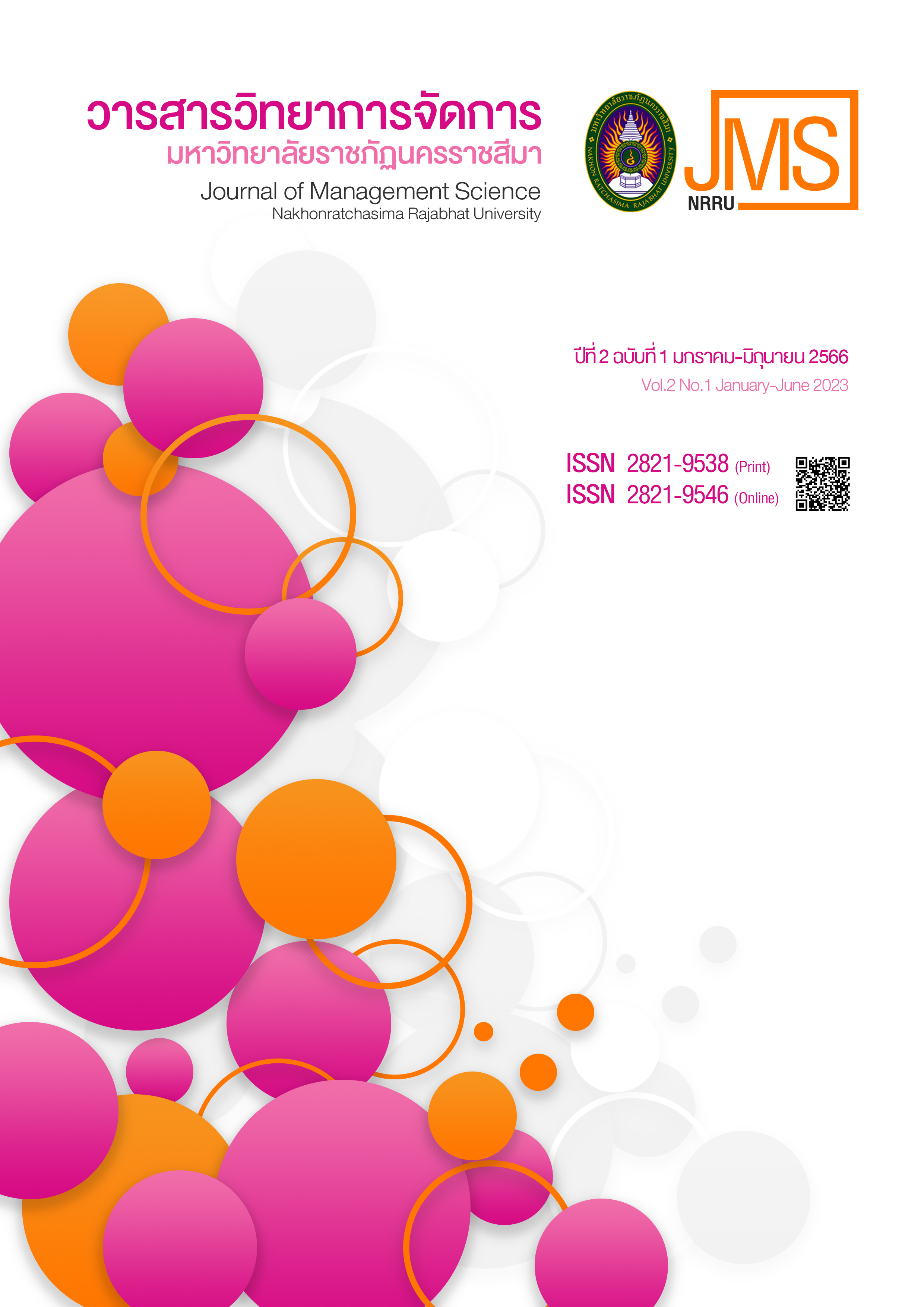Nile Tilapia Supply Chain in Surat Thani Province
Main Article Content
Abstract
The research was conducted by the mixed-methods. The tools were the questionnaire, the in-dept interview form and the focus group. The results revealed that, at the upstream supply chain, 81.67 percent of the breeding procurement came from the fish breeding operators and 18.33 percent from the fish breeding farmers. At the midstream level, the fish farmers shipped 70 percent of their produce to the consolidators, and 30 percent of their produce was sold to the contract farmers. For the downstream level, the contract farmers passed on 13 percent of the produce to the wholesalers, 12 percent to the retailers and 5 percent to the processors. Moreover, the consolidators also shipped 29.17 percent of the produce to the wholesalers, 22.17 percent to the retailers and 18.67 percent to the processors. For the problems and the obstacles in the management of the tilapia business chain, most framers had the transportation problems such as the shipment duration, the high transportation costs, and the marketing problems; the fluctuating price, the lack of competitiveness and the markets to support the sufficient output. It was also found that there was not enough support from the government. In addition, the serious issues should be solved were creating cooperation as a network or a farmers’ group, reducing the cost of production, increasing productivity through the technology and the innovation and processing of tilapia to add value as the quality products. For the suggestion, the proactive marketing and the public relations searching for the new markets should be conducted.
Article Details

This work is licensed under a Creative Commons Attribution-NonCommercial-NoDerivatives 4.0 International License.
บทความในวารสารเป็นลิขสิทธิ์ของวารสารวิทยาการจัดการ มหาวิทยาลัยราชภัฏนครราขสีมา
บทความที่ปรากฎในวารสารเป็นความคิดเห็นของผู้แต่งเพียงอย่างเดียวซึ่งไม่เกี่ยวข้องกับวารสาร
References
กรมประมง กระทรวงเกษตรและสหกรณ์. 2557. การเลี้ยงปลาแบบผสมผสาน. [ออนไลน์]. แหล่งที่มา :
http:// agrimedia.agritech.doae.go.th/book/book-others/OU018.pdf. [20 พฤษภาคม 2565]
กัลยา วานิชย์บัญชา. (2558). สถิติสำหรับงานวิจัย. (พิมพ์ครั้งที่ 9). กรุงเทพฯ : ศูนย์หนังสือจุฬาลงกรณ์หาวิทยาลัย.
เกวลิน หนูฤทธิ์. (2564). สถานการณ์การผลิต ตลาดและการค้าปลานิลโลก ปี 2563. วารสารการประมงอิเล็กทรอนิกส์. 4 (1) : 188-190.
สุจิตตา หงษ์ทอง และคณะ. (2562). โซ่อุปทานปลานิลของเกษตรกรผู้เลี้ยงปลานิลและต้นทุนต่อหน่วย กรณีศึกษา อำเภอพาน จังหวัด เชียงราย. วารสารบริหารธุรกิจเทคโนโลยีมหานคร. 16(1) : 180-199.
สานิตย์ ศรีชูเกียรติ และคณะ. (มกราคม-มิถุนายน 2564). การศึกษาการดำเนินงานโซ่อุปทานสินค้าอาหารทะเลปลอดภัย : กรณีศึกษาวิสาหกิจเพื่อสังคมร้านคนจับปลาสตูล. วารสารเศรษฐศาสตร์และบริหารธุรกิจ มหาวิทยาลัยทักษิณ. 13(1) : 15-34.
สำนักงานประมงจังหวัดสุราษฎร์ธานี. 2559. ครัวเรือนที่เพาะเลี้ยงสัตว์น้ำจืด จำแนกตามประเภทการเลี้ยงและผลผลิตการเลี้ยงสัตวน้ำจืด เป็นรายอำเภอ พ.ศ. 2559. [ออนไลน์]. แหล่งที่มา : https://www4. fisheries.go.th/local/index.php/main/view_blog/1261/148933. [20 พฤษภาคม 2565]
พิชา วิสิทธิ์พานิช และคณะ. (กรกฎาคม-ธันวาคม 2562). ห่วงโซ่คุณค่าในการผลิตและการตลาดผลิตภัณฑ์แปรรูปจากปลาเชิงพาณิชย์ในพื้นที่จังหวัดนครสวรรค์. วารสารวิทยาลัยโลจิสติกส์และซัพพลายเชน.
(2) : 89-100.
สำนักโลจิสติกส์ (2558). SC การไหลเวียนในระบบโซ่อุปทาน (Supply Chain Flow). กรมอุตสาหกรรมพื้นฐานและการเหมืองแร่. [ออนไลน์]. แหล่งที่มา : http:// www.logistics.go.th. [20 พฤษภาคม 2565]
อติญา วงศ์วิทย์วิโชติ, กุลภา กุลดิลก และเดชรัต สุขกำเนิด. (มีนาคม-เมษายน 2564). การประเมินความคุ้มค่า
ทางเศรษฐกิจของโครงการระบบส่งเสริมการเลี้ยงปลานิลแบบแปลงใหญ่ในจังหวัดชลบุรี. วารสาร
แก่นเกษตร. 49(2) : 430-441
เอกชัย เกิดสวัสดิ์. 2562. สถานการณ์ด้านเศรษฐกิจของสหกรณ์ประมงกับทิศทางแนวโน้มปี 2562. [ออนไลน์]. แหล่งที่มา : https://www.cad.go.th/ewt_news.php?nid=40060. [20 พฤษภาคม 2565]
Anane-Taabeah, G., Quagrainie, K., & Amisah, S. (August 2016). Assessment of farmed tilapia value chain in Ghana. Aquaculture international. 24(4) : 903-919. [20 พฤษภาคม 2565]
Islam, I., Nielsen, M., Ehlers, B. S., Zaman, B., & Theilade, I. (2020). Are trade credits a gain or a drain? Power in the sale of feed to pangasius and tilapia farmers in Bangladesh. Aquaculture Economics & Management. 24(3) : 338-354. [20 พฤษภาคม 2565]
Jamandre, W. E., Hatch, U., Bolivar, R. B., & Borski, R. (2011). Improving the supply chain of tilapia industry in the Philippines. In Better science, better fish, better life. 9 th international symposium on Tilapia in aquaculture, Shanghai. (pp. 22-24).
Vivanco-Aranda, M., Mojica, F. J., & Martínez-Cordero, F. J. (March 2011). Foresight analysis of tilapia supply chains (Sistema Producto) in four states in Mexico: Scenarios and strategies for 2018. Technological Forecasting and Social Change. 78(3) : 481-497.
Zhang, X., Feng, J., Xu, M., & Hu, J. (May 2011). Modeling traceability information and functionality requirement in export‐oriented tilapia chain. Journal of the Science of Food and Agriculture. 91(7) : 1316-1325.


